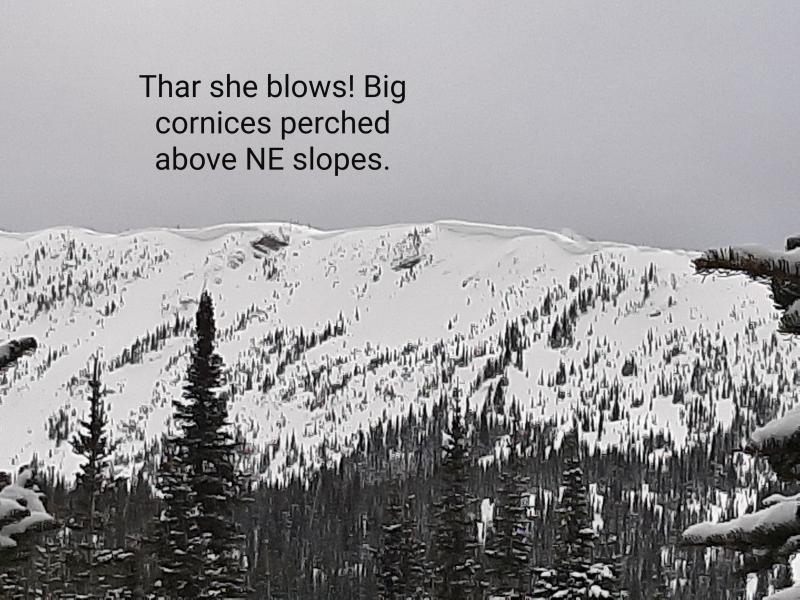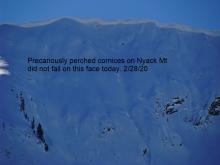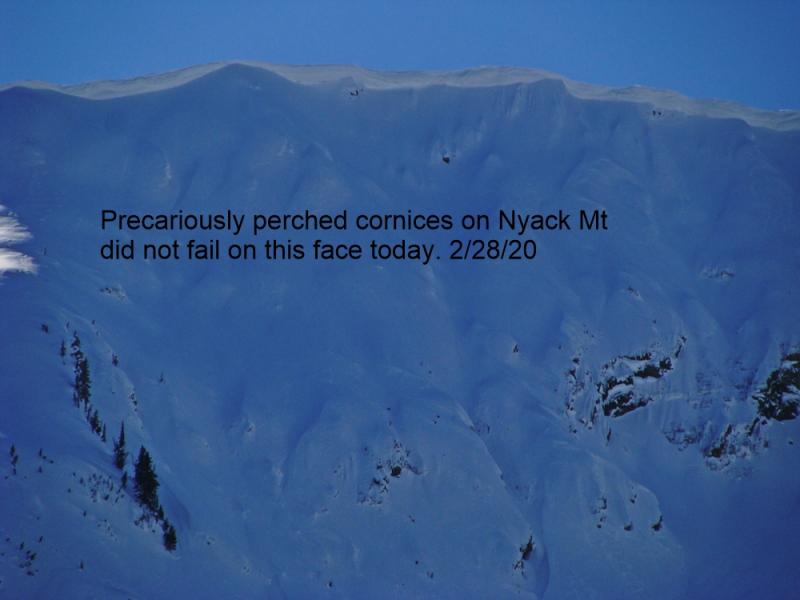| Thursday | Thursday Night | Friday | |
|---|---|---|---|
| Cloud Cover: | Light snow showers this afternoon. | Snow tapering and high pressure building. | Warm with sun and clouds. |
| Temperatures: | 35 to 45 deg. F. | 22 to 28 deg. F. | 37 to 49 deg. F. |
| Wind Direction: | Southwest | Southwest | Southwest |
| Wind Speed: | 11-13 mph with gusts to 29 mph. | 10-15 mph with gusts to 25 mph. | 5-10 mph. |
| Snowfall: | 0-1 in. | 0-1 in. | 0 in. |
| Snow Line: |
Whitefish Range
Swan Range
Flathead Range and Glacier National Park
How to read the forecast
Strong to extreme winds and a bit of new snow earlier in the week formed wind slabs and sensitive cornices. Heightened avalanche conditions exist above 5500 ft. and human triggered avalanches are possible. Carefully evaluate all wind loaded terrain, A layer of buried surface hoar exists about 0.5-1.5 feet below the surface and warrants investigation. The danger is MODERATE above 5500 ft. and LOW below.

2. Moderate
?
Above 6500 ft.
2. Moderate
?
5000-6500 ft.
1. Low
?
3500-5000 ft.
- 1. Low
- 2. Moderate
- 3. Considerable
- 4. High
- 5. Extreme
-
Type ?
-
Aspect/Elevation ?
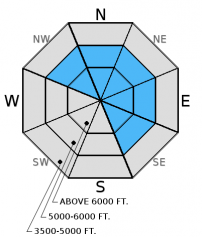
-
Likelihood ?CertainVery LikelyLikelyPossible
 Unlikely
Unlikely -
Size ?HistoricVery LargeLargeSmall

Strong to extreme winds Tuesday into Wednesday (average speeds in the 30-40 mph range and gusts to 56 mph) formed fresh wind slabs. In my travels today, I will continue to treat all wind loaded terrain as suspect, and still avoid steep, wind loaded slopes at upper elevations. Yesterday, we found wind slabs to be stubborn to triggering on small test slopes at 5500-6400 ft., but we were also not along the highest ridges where wind loading is more pronounced and slabs are likely more sensitive. In some areas recent slabs may have formed on a preserved layer of surface hoar making them more sensitive. In other areas they may have been deposited on a recently formed sun crust or rain crust; both of which will provide a great bed surface for these fresh slabs to slide on.
-
Type ?
-
Aspect/Elevation ?
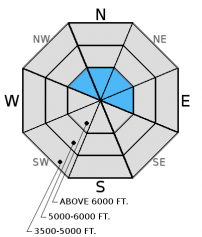
-
Likelihood ?CertainVery LikelyLikelyPossible
 Unlikely
Unlikely -
Size ?HistoricVery LargeLargeSmall

Recent strong winds have added size and weight to existing cornices. Cornices can fail naturally during periods of formation or periods of warming. As we approach spring and daily maximum temperatures rise above freezing, cornices may become more sensitive. Cornice failure can also be triggered by the weight of a skier or rider, and Tuesday we found cornices that failed easily from the weight of a skier (observation). Cornices can also trigger slab avalanches on the slopes below.
Additional Conerns: A layer of buried surface hoar exists 6-14 inches below the surface in many areas. Currently, this layer is not very reactive in stability tests, but this could change. It is important to dig into the snow, see where the layer is, and test the reactivity of this layer with stability tests. There is a reason surface hoar accounts for most uninentional human triggered avalanches by professionals. It can be tricky and spotty in distribution.
Also, the snow level should be around 5000 feet, but pay attention to changing conditions and the possbility for wet, loose sluffs at lower elevations.
Wednesday: In Cascade Creek in the Flathead Range, we found stubborn wind slabs on wind loaded slopes, but still did not trust wind loaded terrain. We also found buried surface hoar 6-14 inches from the surface in more shaded areas sheltered from the wind (observation) that fractured but did not propagate in extended column tests. Lower elevation snowpack is dwindling rather quickly and has become more spring-like.
Tuesday: We traveled to Sub-Shields in southern Glacier Park and found evidence of recently formed wind features and cornices at mid and upper-elevations. The cornices were soft and broke easily with the weight of a skier. There was a supportable crust to 6300 feet with a thin layer of new snow on top of this. We also found a decomposing layer of surface hoar 10 inches below the snow surface (observation).
Monday: USFS snowmobile observers were in the Doris/Alpha area of the northern Swan Range. They noted substantial ridgetop winds with associated wind loading down to 6000'.They were able to intentionally release small thin wind slabs in the new snow by kicking and ski cutting wind features (observation). Skiers in the southern Whitefish Range reported sluffing of the new snow in Canyon Creek.
Sunday: Skiers in Cascade Creek in the Flathead Range noted a 1 inch thick surface crust to 6000 feet. They reported good skiing above that and "interesting" skiing at low elevations.
Saturday: Erich was instructing an avalanche class in the Ghoulie Point area in the southern Whitefish Range. He noted active windloading along the ridgelines and surface hoar that was preserved and buried beneath 1-2 inches of new snow. Participants in the class also noted surface hoar in the area. Stability tests produced variable fractures in the upper snowpack without propagation (observation). Mark and Guy traveled to the Napa Point area in the Swan Range and noted the snow level was at 5900 feet and the area picked up 4 inches of dense snow above that. They also had minimal results in stability tests (observation).
Visit our Observations page and our You Tube channel for more observations from the entire season.
Thanks to everyone for submitting observations. They are extremely useful and could help save lives.
HOW TO SUBMIT OBSERVATIONS:
Email: [email protected]
Call and leave a message: 406.387.3821
You can also submit quick observations via text: 406.241.4571 (FAC mobile)
OR
Submit Snowpack Observations: http://www.flatheadavalanche.org/node/add/snowobs
Submit Avalanche Observations: http://www.flatheadavalanche.org/node/add/avyobs
Snow tapered in the afternoon yesterday with storm totals of about 2-4 inches with continued strong winds. As of 6:00 a.m.temperatures above 6000 feet are 24-29° F and winds are out of the southwest 2-14 mph with gusts from 3-23 mph. Today, temperatures should climb to the low to mid-30s F again, and winds will blow out of the southwest at 15-25 mph with gusts to 40 mph. Another quick moving storm will move through today dropping 1-2 inches of snow before tapering this evening. Tomorrow, a ridge of high pressure builds with warm temperatures and sunshine.
| 0600 temperature: | 24 to 29 deg. F. |
| Max. temperature in the last 24 hours: | 27 to 33 deg. F. |
| Average wind direction during the last 24 hours: | Southwest |
| Average wind speed during the last 24 hours: | 7-43 mph |
| Maximum wind gust in the last 24 hours: | 13-53 mph |
| New snowfall in the last 24 hours: | 1-2 inches |
| Total snow depth: | 76-102 inches |
This advisory applies only to backcountry areas outside established ski area boundaries. This advisory describes general avalanche conditions and local variations always occur. This advisory expires at midnight on the posted day unless otherwise noted. The information in this advisory is provided by the USDA Forest Service who is solely responsible for its content.

















